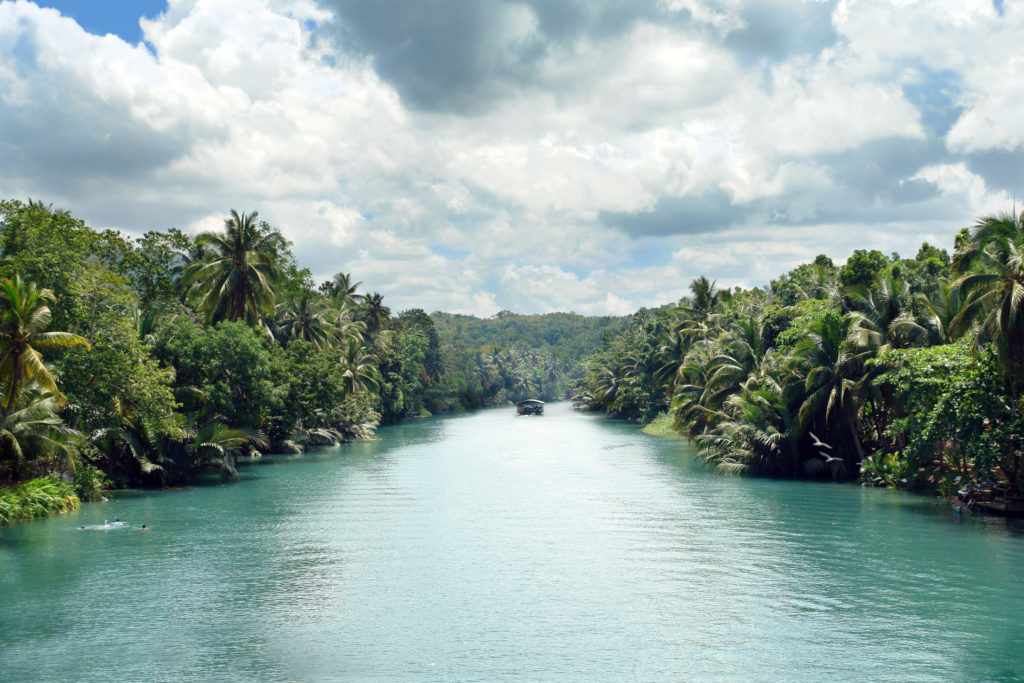Photo above: Tropical River in Bohol Region of the Philippines, Adobe Photos
Women’s Empowerment as a Path Toward Sustainable Development: Integrating Rights-Based Reproductive Health Solutions for Climate Resilience in the Philippines
Case Study featuring PATH Foundation Philippines Inc. (PFPI)
Hannah Evans and Alex Casey, edited by Janet Larsen
2022
“A multisectoral approach seeks to interrupt the cyclical nature of high fertility, environmental degradation, and poverty by simultaneously addressing these various factors under one set of interventions.”*
“In an overwhelmingly Catholic country, [PHE] has also proven to offer an “acceptable” rationale for prioritizing investment in family planning, which remains out of reach for many. One in 10 Filipino adolescents (ages 15 to 19) have already begun childbearing, yet half of all pregnancies are unintended and the vast majority are due to a lack of modern methods of contraception.”*
“I’d like to see PHE throughout the Asia Pacific region. I think that’s always been my vision, to go beyond the Philippines [to] having more countries understanding and knowing what PHE is all about.”* — Joan Castro, MD, Executive Vice President, PATH Foundation, Philippines (PFPI)
This document presents a case study in which community-led population, health, and environment (PHE) strategies have been implemented as a means of successfully advancing community development, women’s empowerment, and climate resilience. It details the initiatives of PATH Foundation Philippines Inc. (PFPI)—a nonprofit organization and partner of Population Connection—to highlight its impactful contributions to community-led sustainable development throughout many at-risk Filipino communities.
*Grodin M, Harlan SV, and Apcar N. History of Population, Health, and Environment Approaches in the Philippines. Baltimore, Maryland: Johns Hopkins Center for Communication Programs; 2021.
Overview
The Philippines—a beautiful and quickly growing archipelagic country of 7,640 islands—is one of the world’s most climate vulnerable nations. Despite the country’s vast potential for growth and prosperity, its fast-growing population has experienced uneven economic growth hampered by financial shocks, prolonged armed conflicts, and deadly natural disasters. Widespread poverty and gender inequality, along with a lack of access to voluntary reproductive health information and services, fuel high fertility and exacerbate the effects of the climate crisis, inhibiting sustainable development and endangering the lives of millions of people [1,2]. Rights-based advancements in reproductive health care, women’s empowerment, and climate adaptation are needed to promote economic growth, resilience, and capacity building without furthering environmental harm.
This case study examines the state of reproductive rights and climate vulnerability in the Philippines and highlights the work of PATH Foundation Philippines Inc. (PFPI) in establishing impactful community-led development programs. The outcomes of PFPI’s projects demonstrate that access to quality reproductive health care strengthens both climate resilience and sustainable development.
PFPI: A Model for Population, Health, and Environment (PHE) and Community-Led Development Solutions
The Philippines is rich in biodiversity and contains a wide array of natural resources; yet, like many developing countries, it is subject to the compounding issues of widespread inequality, high climate vulnerability, environmental degradation, and significant unmet need for comprehensive reproductive health care and voluntary family planning services. PFPI offers unique and effective interventions that address these intersecting development challenges. PFPI’s approaches toward women’s sexual and reproductive health care and community-led resource management make the organization a model for advancing culturally competent development solutions throughout at-risk regions, which ultimately help communities weather the challenges of climate change.
Community-led, integrated strategies that work across social, economic, and environmental sectors have been shown to effectively promote sustainable development [3-6]. Such methods that recognize the connections among population dynamics, individual and community health, and environmental conservation are known as population, health, and environment (PHE) approaches [7,8]. PHE approaches address development challenges comprehensively rather than in isolation (Figure 1). For example, development efforts focused in areas such as food and water security and natural resource management also incorporate family planning and reproductive health care— a holistic PHE approach that ultimately enhances climate resilience.
PFPI is a nonprofit organization, founded in 1992, that engages communities in development solutions for human and ecosystem health challenges. PFPI’s integrative approach increases access to voluntary family planning services, climate-smart development strategies, sustainable fisheries management systems, and tools for women’s empowerment. The organization has pioneered PHE development initiatives throughout the Philippines, successfully collaborating with multi-sectoral stakeholders at local, regional, and national levels. Its community-centric model has spread from its initial projects in the southern Philippines to other areas of the country and internationally through targeted learning exchanges.
PFPI works strategically within communities to build resilience through knowledge sharing and empowerment, with an emphasis on peer education. Its programs are centered on addressing population growth and coastal resource depletion, which intersect to impact sustainable development and fisheries management in rural at-risk regions [9].
Specifically, PFPI trains peer educators in resource management, works with local municipalities to offer subsidized contraception at convenience stores, and engages community members and local municipalities to collectively support behavior change through education and capacity building. PFPI’s PHE approach—integrated throughout most of its projects—recognizes the interconnections among livelihoods, ecosystem health, and human health and helps lessen the social, economic, and environmental impacts of climate change.
Background: The Philippines in Focus
High Population Growth and Uneven Economic Progress
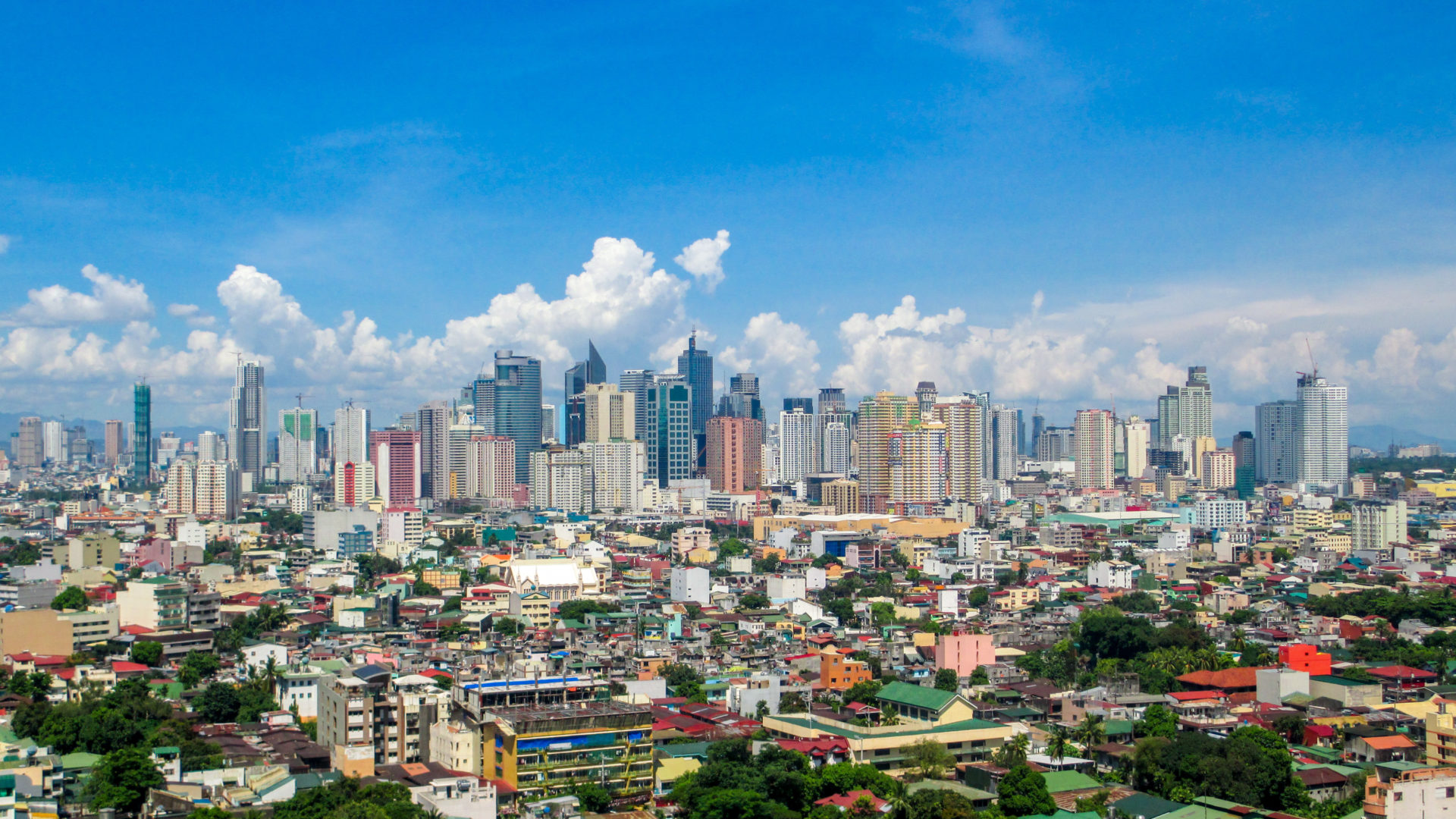
area encompasses about 14.4 million people. Adobe Photos.
The Philippines is home to an estimated 112 million people as of 2022 [10]. With one of the highest population growth rates in Southeast Asia, the Philippines’ population is projected to reach 145 million by 2050 [10]. Prior to the Covid-19 pandemic, the economy of this newly industrialized emerging market was also growing rapidly as focus shifted away from a reliance on agricultural exports to services and manufacturing [2].
With pre-pandemic economic growth rates among the world’s highest, the Philippines’ economy was projected to quadruple by 2050 [11]. However, challenges like persistent political corruption and wide disparities in wealth and growth make the country’s economic future somewhat uncertain. As the Asian Development Bank notes, high population growth rates, which undermine development, tend to be associated with low levels of economic growth and higher incidence of poverty [12]. Economic growth over the past 40 years has had little positive impact on the Philippines’ poorest citizens; as of 2018, 17% of the population was living below the national poverty line. The World Bank estimates that the economic fallout of the Covid-19 pandemic reversed already meager poverty improvements, bringing the poverty rate back above 21% in 2021 [13].
Poverty and high population growth are self-reinforcing. As in many other parts of the world, particularly in developing regions, disparities in health outcomes according to gender, age, education level, income, and race are rampant in the Philippines [14,15]. While wealthier women tend to end up with families of one or two children, close to their desired size, the poorest Filipino women have five children on average— two more than they say they would have preferred [16].
The Philippines has a significant unmet need for contraception and reproductive health care services. As of 2019, 13 million Filipino women of reproductive age (15–49) wanted to avoid a pregnancy, yet 5.5 million (43%) of them were not using modern contraceptives, according to data from the Guttmacher Institute [17]. Additionally, restrictive abortion laws result in dangerous, back-alley procedures that kill hundreds of women each year [2,18,19]. Exact figures are hard to come by due to religious taboos and unclear or unrepresentative reporting, but an estimated 27 out of every 1,000 Filipino women of reproductive age have had an abortion [20,21].
Structural inequalities in health care prevent hundreds of thousands of the 2.2 million women who give birth each year in the Philippines from receiving adequate pre- and postnatal care [17,18]. Maternal and infant mortality—both of which have been worsened by the Covid-19 pandemic— are relatively high for the region[22].Gender-based violence, which also increased during the Covid-19 lockdowns, pervades the country’s social systems, and acutely affects rural communities [14,15,23]. Cultural norms surrounding child marriage, along with lagging reproductive health education, continue to drive high rates of early marriage, so much so that the Philippines Commission on Population and Development considers teen pregnancy a “national social emergency” [24-26]. Teen birth rates are more than twice the average across East Asia and the Pacific [2]. In recent years, 55 of every 1,000 Filipino adolescents aged 15 to 19 have given birth—over 500 teens each day [2, 27].
The Politics of Reproductive Health in the Philippines
Following the 1994 International Conference on Population and Development, the Philippines joined the global community in adopting a more rights-based reproductive health framework [28]. In theory, this approach seeks to slow population growth by increasing access to family planning services and education, which together facilitate voluntary reductions in fertility. In practice, however, inconsistent and insufficient funding and a heavy religious influence have contributed to widespread disparities in access to quality care for the country’s citizens [28].
In the Philippines, women’s reproductive rights have been chronically entangled in the contrasting ideologies of the Catholic Church, partisan politics, and international Sustainable Development Goals that view bodily autonomy as a basic human right [19,29]. For example, the landmark Responsible Parenthood and Reproductive Health Act that was enacted in December 2012 (referred to as the “Reproductive Health Law”) allocated funding for the supply of free contraceptives to the poor [19,30]. However, within months, anti-abortion groups, in collaboration with the Catholic Church, brought a challenge to the law to the Supreme Court, halting its implementation [19]. In 2014, the Supreme Court reversed this decision and ruled that the 2012 law was constitutional, save for eight provisions, including one that would have allowed minors who were previously pregnant to receive reproductive health care without parental permission [18,19]. Then, in 2016, the Filipino government instituted draconian cuts to family planning services, eliminating access to contraceptives for the 13.4 million low-income women who rely on government funded health care, effectively rendering the Reproductive Health Law moot [31,32].
A 2017 executive order by President Rodrigo Duterte restored funding for contraceptives in accordance with the 2012 Reproductive Health Law [32]. This move has been pivotal in improving maternal health outcomes and reducing infant and maternal mortality rates [2, 33,34]. The Philippine government has since committed to improving health outcomes for low-income populations through the provision of various social services, including free comprehensive reproductive health care and contraceptives, improved public health facilities, and increased numbers of health providers. While these measures have had some positive impact, large discrepancies in access to and quality of care remain [27,34].
Climate Vulnerability and Coastal Ecosystem Damage
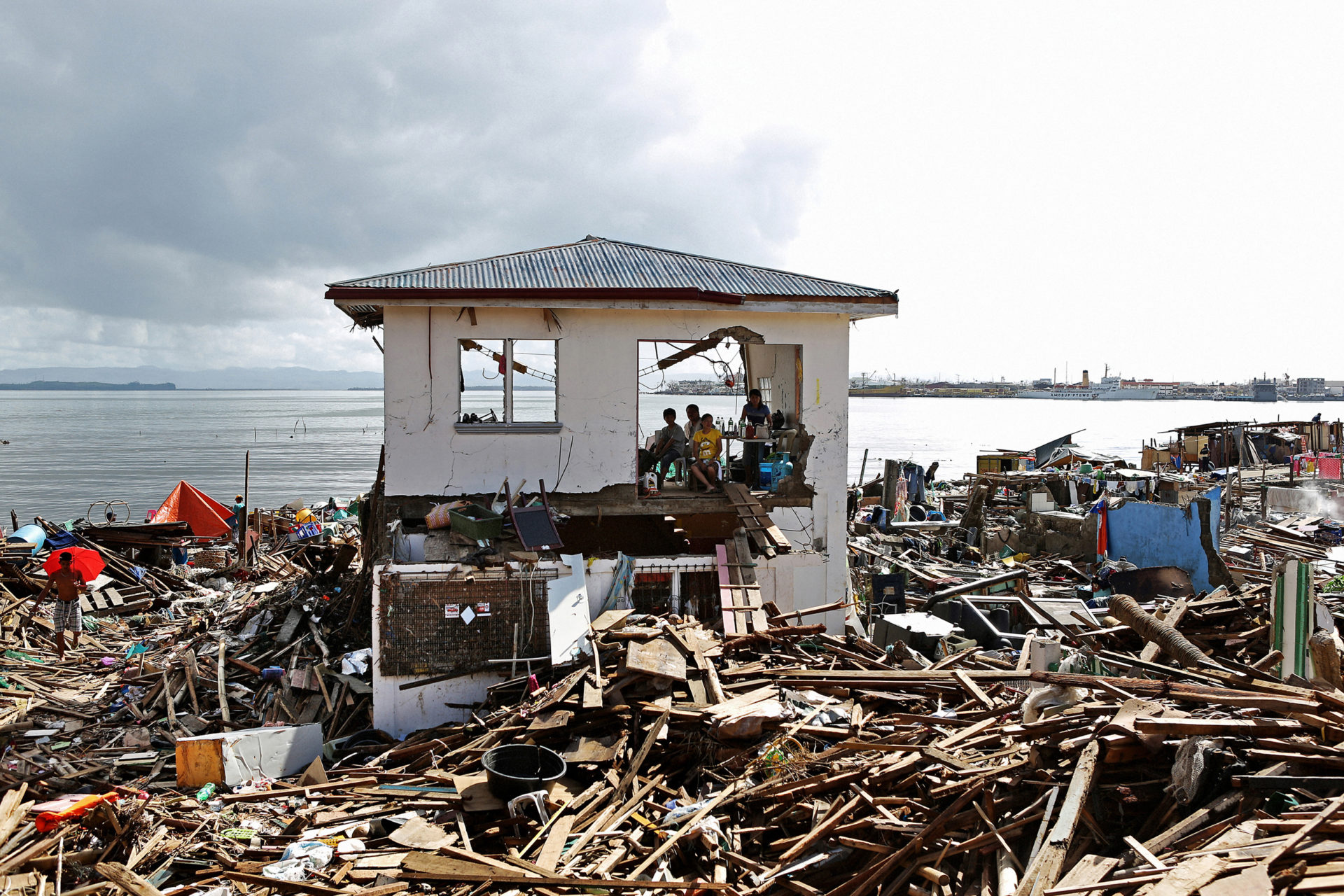
According to German Watch’s climate risk index, the Philippines is one of the most climate vulnerable countries on Earth [35]. Risks include sea level rise, unpredictable weather patterns, biodiversity loss, food insecurity, economic instability, and health crises [36]. The disruption the Philippines faces from climate change is disproportionate to its responsibility for the problem: the country’s annual contribution to global carbon dioxide emissions represents 0.4% of the global total, and per capita carbon footprints are negligible [37].
The Philippines’ geography makes it vulnerable to flooding and other natural disasters. Although tropical storms have long been common in the Philippines, higher temperatures are strengthening cyclones and lengthening storm seasons, all while higher seas are amplifying storm surges and flooding [38]. Super Typhoon Rai—which tore through the Philippines in December 2021 with extreme rainfall and winds up to 270 kilometers (168 miles) per hour, destroying critical infrastructure and inciting large-scale flooding, exemplifies this type of climate disaster. The mega-storm’s impact was widespread, but was particularly hard felt throughout Bohol province, one of the main areas where PFPI works [39]. Over 7 million people were affected, and more than 400 died [40]. A month after the storm, over half a million people remained displaced [40]. Super Typhoon Rai was the world’s deadliest storm in 2021 and the third Category 5 strength storm to make landfall in the Philippines in two years—historically a rare event [40,41].
Rising seas worsen flooding from storm surges. Sea level rise in the Philippines—three times higher than the global average—puts more than 13 million Filipinos at risk of relocation [36]. As most of the Filipino population lives within 80 kilometers (50 miles) of the country’s 36,000 kilometers (22,000 miles) of coastlines, the total number of people affected by progressively rising seas will likely be much higher in upcoming years and decades [9].
As the country’s population continues to grow, more people will inhabit climate-vulnerable areas, endangering both human and ecological health. Growing populations and climate change together threaten the availability and equitable distribution of natural resources and can degrade local ecosystems. They also compound the damages from unsustainable agricultural and fishing practices on marine ecosystems and fish populations [42]. Human activities in some coastal areas have damaged and destroyed vital mangrove ecosystems which provide natural buffers against storm surges and aid in nutrient cycling. Overfishing and environmental degradation have also resulted in smaller fish harvests [42].
Climate impacts and environmental degradation throughout some of the Philippines’ most at-risk communities fuel displacement, inequality, and food insecurity, while a lack of access to voluntary family planning and sexual and reproductive health services undermines both development and climate resilience. Limited and uncertain access to family planning hampers development by fueling higher rates of unintended pregnancy, which poses risks to maternal and infant health and survival, especially in low-income and developing regions. High rates of unintended pregnancies result in higher population growth rates and can contribute to social, economic, and environmental pressures. These pressures weaken individual and state resilience to climate impacts by increasing competition for scarce natural resources, including food and fresh water, and by reducing access to social resources like education, health care, and employment. Conversely, access to quality, comprehensive reproductive health care services leads to better health outcomes, lower rates of unintended pregnancies, and slower population growth over time—all of which help individuals, communities, and societies better adapt and respond to a changing climate.
PFPI’s Introduction of Population, Health, Environment (PHE) in the Philippines
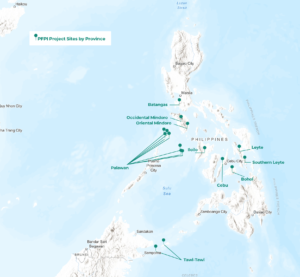
To aid development in densely populated communities dependent on coastal resources for survival and economic stability, PFPI launched the Philippines’ first PHE initiative two decades ago: the Integrated Population and Coastal Resource Management program (IPOPCORM) [43]. Running from 2000–2008 and serving as a model to the present, IPOPCORM employed a three-tiered approach to improve reproductive health outcomes, implement sustainable coastal and marine resource management practices, and facilitate community-based environmental education for
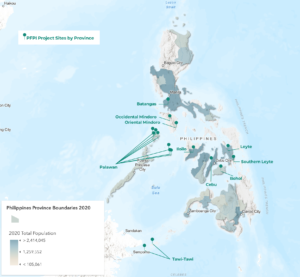
the conservation and sustainable management of coastal ecosystems [9].
IPOPCORM’s peer education model trained both adults and youth in environmental stewardship. Trained peer educators then led separate workshops and trainings in which new information and best practices were shared with community members in open-ended discussions. This included educating community members about the destructive effects of fishing with dynamite and cyanide, as well as supporting environmentally conscious business practices like seaweed harvesting [9].
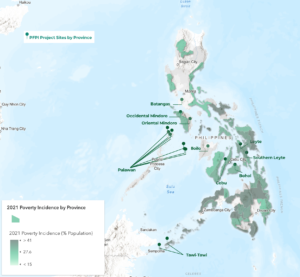
Additionally, IPOPCORM increased access to voluntary family planning services by working with local municipalities to supply contraceptives at convenience stores. This initiative was supplemented through communitywide information sessions on sexual and reproductive health and rights (SRHR). Under IPOPCORM, PFPI produced several written resources about SRHR and led leadership trainings for women. In the educational sessions, women learned about traditionally taboo topics like menstruation, early pregnancy, and menopause. Men were also included in SRHR discussions led by trusted Indigenous leaders who could talk candidly among fishing communities, providing sexual health education and clarifying the benefits of using family planning to improve wellbeing [44]. The conversations also encouraged men to engage with their communities as peer educators and advocates for SRHR.
IPOPCORM was first launched in Palawan and Bohol provinces and expanded to over 1,000 communities in 33 coastal municipalities in eight southern provinces, serving more than 56,000 households (see map) [45]. The results of the program were impressive. Between 2003 and 2006, household income increased by 20%, while family planning use nearly doubled, from 43% to 83% [9]. Coastal resource stewardship, the recovery of endangered fisheries, and increased food security also improved. According to PFPI, these improvements have been sustained throughout the years since these metrics were calculated.
Before IPOPCORM, there were 17 marine biodiversity sanctuaries in designated project areas. PFPI and partner organizations established 71 new sanctuary locations, including 45 fish preserves and 26 mangrove and migratory bird protected areas [44]. More fishers became involved in voluntary sanctuary protection efforts, and communities developed medium- to long-term environmental management plans that incorporated family planning [44,46].
PFPI also trained women to become managers of endangered ecosystems, namely of mangroves and marine corridors (naturally occurring pathways in the ocean that support and protect marine life). The female-led, grassroots initiative helped women become recognized environmental stewards within their communities and throughout their broader geographical regions.
By positioning women as decision makers and land managers, IPOPCORM helped forge an important way forward for women’s participation in community development and natural resource management practices. IPOPCORM paved the way for PFPI’s subsequent PHE programs in the Philippines. Later projects expanded progress in the areas of coastal resilience, gender equality, access to reproductive health care, and slower population growth (see side bars on pages 9-11).
PFPI Projects
I. BALANCED: Building Actors and Leaders for Advancing Community Excellence in Development (2008–2013)
■ The BALANCED Project used the success of IPOPCORM to expand PHE initiatives throughout 28 municipalities in Bohol province and to promote similar programs in other countries. PFPI partnered with Conservation International and the University of Rhode Island to scale up the PHE capacities of national and local governments. Key initiatives included improving access to voluntary family planning, increasing local policymakers’ and community members’ commitment to the expansion of reproductive health services, and improving government capacities for coastal fishery management. BALANCED brought together local governments, non-governmental organizations, youth groups, and private entrepreneurs to build community-based family planning distribution systems. It strengthened the management of 12 marine protected areas using information campaigns about integrated health and conservation activities. The project also aided conservation management by encouraging complementary alternative livelihoods, such as seaweed production and dress making. Longer term, BALANCED worked with policy makers to integrate family planning and biodiversity conservation into formal municipality plans that addressed population and health issues.
■ Another component of BALANCED was its cross-institutional learning exchanges with representatives from Ethiopia, Ghana, Indonesia, Kenya, Tanzania, the Philippines, and the United States. Experienced PHE practitioners paired with less experienced practitioners to share PHE skills and support. Participants learned about engagement with rural governments, increasing access to family planning in communities, and integrated strategies to mitigate rural poverty, health challenges, and environmental pressures.
Source: PATH Foundation Philippines Inc. Building Actors and Leaders for Advancing Community Excellence in Development Project (BALANCED Philippines). 2012, at www.pfpi.org/balanced-philippines.html; Grodin, M., S. Harlan, and N. Apcar, History of Population, Health, and Environment approaches in the Philippines. 2021, Johns Hopkins Center for Communication Programs: Baltimore.
II. EMPOWER: Empowering Rural Youth with Population Health Environment and Enterprise Development Know-How (2011–2014)
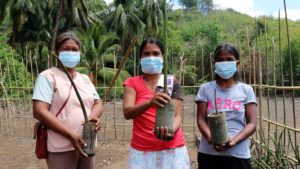
management project in Bohol, Philippines. PFPI 2020.
■ Centered in the Danajon Bank and Verde Island Passage marine biodiversity hotspots, EMPOWER continued to implement coastal conservation activities, with more emphasis on engaging youth in communities dependent on fisheries for survival. Its overall goal was to inspire youth leaders to spearhead voluntary family planning initiatives, coastal conservation, and economic development activities that would reduce dependency on fishing. EMPOWER involved youth in project design, implementation, and conversations about population growth and natural resource availability. By the end of the project, PFPI reported improved reproductive health outcomes among young people living in the coastal areas, reduced food insecurity, and improved awareness of community-led PHE approaches to coastal resource management
“Spacing children is important to make women healthier. I have more time to conserve the mangroves and the seas, which is a source of our food and livelihood.” – Marcelita, member of a women-managed mangrove area
Source: PATH Foundation Philippines Inc. Project EMPOWER. 2012, at www.pfpi.org/project_empower.html.
III. BUILD: Building Capacity for Integrated Family Planning & Reproductive Health and Population, Environment and Development Action (2021–2026, planned)

■ BUILD is an international USAID-funded project involving the African Institute for Development Policy (AFIDEP) and partners Leadership for Environment and Development Southern and Eastern Africa (LEAD SEA), PFPI, Pan-African Climate Justice Alliance (PACJA), and Family Health International 360 (FHI360). The two main goals are (1) to strengthen capacity for individuals and institutions through PHE approaches and (2) to boost political and financial commitment to family planning and integrated PHE approaches that increase gender equality and youth empowerment internationally. BUILD will work with host country governments, donors, and partners to integrate PHE concepts into sustainable development and economic growth initiatives, with the aim of increasing commitment to voluntary family planning and reproductive health, as well as other solutions to integrated population, gender, and equity issues.
Source: USAID. USAID announces new award to strengthen cross-sectoral benefits of family planning. BUILD: Building Capacity for Integrated Family Planning & Reproductive Health and Population, Environment and Development Action to help meet demand for voluntary family planning and other development sector outcomes. 2021, at www.usaid.gov/global-health/health-areas/ family-planning/news-and-updates/usaidannounces-new-award-strengthen.
Reflections
The Connections between Climate Justice and Gender Justice

The impacts of climate change are widespread and global in scope, but hit women and people living in poverty the hardest [47]. While climate change also affects men and boys, including in their loss of livelihoods or educational opportunities, women and girls collectively are poorer and more directly dependent on climate-sensitive natural
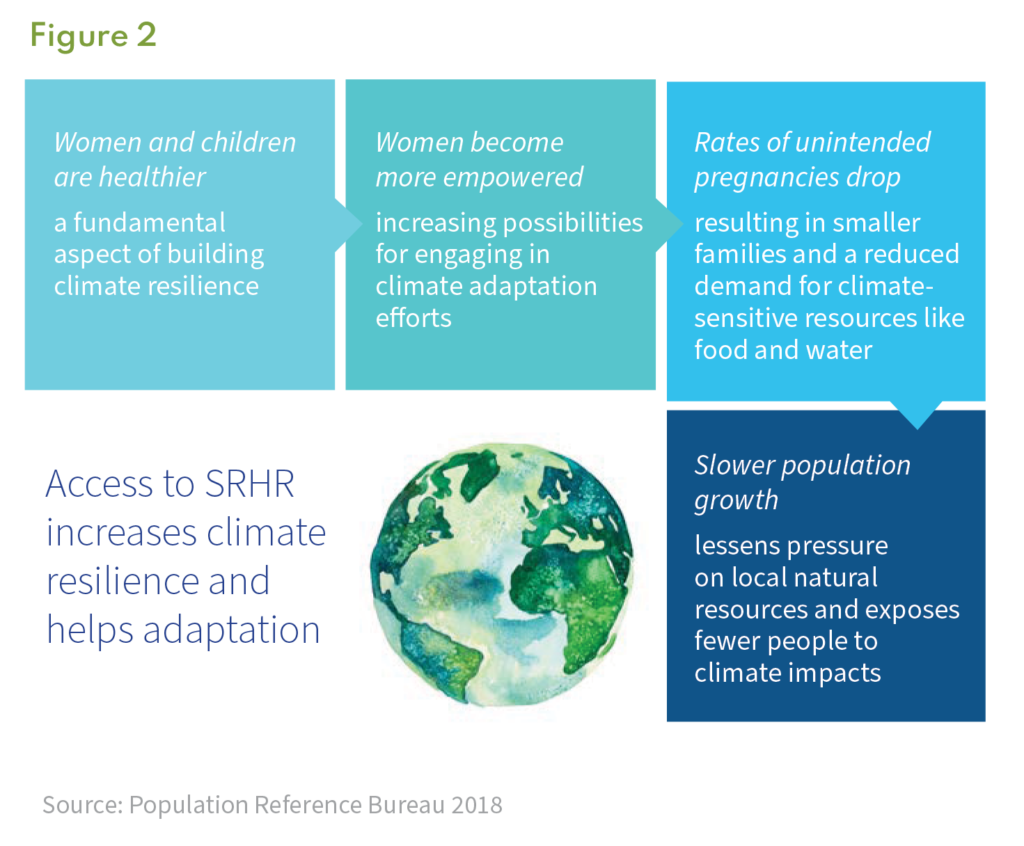 resources for sustenance and livelihoods [48-51]. For example, women and girls bear more of the responsibility of securing water and food for families than male family members, yet also are more likely to suffer from food insecurity [48]. Patriarchal social structures— predominant in much of the world’s poor, rural regions—leave women with limited access to mobility, education, health care, and other vital resources. Women also are more likely to be excluded from decision-making processes [52].
resources for sustenance and livelihoods [48-51]. For example, women and girls bear more of the responsibility of securing water and food for families than male family members, yet also are more likely to suffer from food insecurity [48]. Patriarchal social structures— predominant in much of the world’s poor, rural regions—leave women with limited access to mobility, education, health care, and other vital resources. Women also are more likely to be excluded from decision-making processes [52].
From a health standpoint, climate change jeopardizes the availability of clean air, water, food, and shelter. In low-income regions, especially—where poverty is often accompanied by high rates of unintended pregnancy, food insecurity, limited access to capital, lack of economic opportunity, and high unmet needs for reproductive health care and voluntary family planning services—the unpredictable weather associated with climate change compounds structural inequalities [53]. Extreme weather events can disrupt supply chains and cut off access to reproductive health care services and contraceptive supplies. Climate change can worsen existing injustices like gender-based violence and child marriage [51].
Unmet need for family planning in at-risk regions increases climate vulnerability and inhibits the ability of individuals, households, and communities to adapt to a changing climate, magnifying new and existing inequalities. In contrast, meeting needs for family planning and sexual and reproductive health services helps to bolster resilience and adaptive capacity.
Population, Health, and Environment (PHE) and Climate Resilience


Meeting the unmet need for voluntary family planning is crucial for climate resilience. When women have access to quality, comprehensive reproductive health care, their overall health improves alongside that of their children [54]. Healthier populations have better chances of withstanding and recovering from climate impacts. Reducing unintended pregnancies also leads to higher education rates and more economic stability for women and their households [55]. Women’s empowerment and reproductive autonomy allow them to participate in climate adaptation efforts. Over time, improvements in the health of women and their families slow population growth, reducing localized pressures on climate-sensitive natural resources—including food and water supplies—and exposing fewer people to climate risks (Figure 2) [4,51].
Increasing access to quality, comprehensive reproductive health care and voluntary family planning yields multiple social, economic, and environmental benefits. One example of this is the fact that improving health outcomes and fostering women’s empowerment together enhance resilience to climate change. PFPI demonstrates that women’s empowerment initiatives involving both health and education can promote better environmental management, improved natural resource conservation, and a more egalitarian community structure.
By positioning reproductive rights and access to family planning at the center of its community-led development framework, PFPI’s work provides empirical backing for the potential of PHE and integrated empowerment and rights strategies to improve climate resilience and adaptation. This is a model that could be replicated in global communities facing the confluence of environmental degradation and gender disparities. With the recognition that the climate crisis is a social justice issue, women’s rights are inseparable from climate solutions.
For more information on the links between population dynamics, access to health care, and climate change on a global scale, download our informational briefs, available for free online at populationconnection.org.
Sources
1. USAID. Climate risk profile: Philippines. https://www.climatelinks.org/resources/climate-risk-profile-philippines.
2. World Bank. (2021). DataBank: World development indicators
3. Hardee, K., et al. (2018). Family planning and resilience: Associations found in a Population, Health, and Environment (PHE) project in Western Tanzania. Population and Environment, 40(2), 204-238.
4. Mogelgaard, K., & Patterson, K. P. (2018). Building resilience through family planning and adaptation finance (Population Reference Bureau Policy Brief, Issue. https://www.prb.org/wp-content/uploads/2018/03/18-057-Building-Resilience-Through-FP-and-Adaptation-Finance-2018-03-20-1555_FINAL.pdf
5. Mohan, V., et al. (2020). Building community resilience to climate change: The role of a Population-Health-Environment programme in supporting the community response to cyclone Haruna in Madagascar. Jàmbá: Journal of Disaster Risk Studies, 12(1), 1-4.
6. Singleton, R. L., et al. (2019). Conservation, contraception and controversy: Supporting human rights to enable sustainable fisheries in Madagascar. Global Environmental Change, 59, 101946.
7. USAID. (2010). Population, Health and Environment (PHE) projects by country. http://www.ehproject.org/phe/phe_projects.html
8. USAID. (2019). Population, Health, and Environment toolkit. Knowledge SUCCESS (Strengthening Use, Capacity, Collaboration, Exchange, Synthesis, and Sharing) Project. https://toolkits.knowledgesuccess.org/toolkits/phe
9. Grodin, M., et al. (2021). History of Population, Health, and Environment approaches in the Philippines. https://peopleplanetconnect.org/ wp-content/uploads/2020/12/Phlpn-PHE-Report_v4-Final-DIGITAL.pdf
10. United Nations. (2019). World population prospects database. https://population.un.org/wpp
11. Hawksworth, J., et al. (2017). The long view: How will the global economic order change by 2050. https://www.pwc.com/gx/en/world-2050/ assets/pwc-world-in-2050-summary-report-feb-2017.pdf
12. Aldaba, F. H., Camilla, et al. (2009). Poverty in the Philippines: Causes, constraints, and opportunities. https://www.adb.org/sites/default/ files/publication/27529/poverty-philippines-causes-constraints-opportunities.pdf
13. World Bank. (2021). Regaining lost ground, revitalizing the Filipino workforce (Philippines Economic Update, December 2021 edition, Issue. https://documents1.worldbank.org/curated/en/099710012062131492/pdf/P1774080b8d6f508b0944c08618e5c8a18d.pdf
14. Ladia, M. A. J., & Parreño, N. E. (2020). Philippines: Gender-based violence policy and institutional mapping report. https://thedocs.worldbank.org/en/doc/e1575832e43d4030373f9a616975364f-0070062021/original/Philippines-Gender-Based-Violence-Policy-and-Institutional-Mapping-Report.pdf
15. UNFPA. (2021). State of world population 2021. https://www.unfpa.org/sites/default/files/pub-pdf/SoWP2021_Report_-_EN_web.3.21_0.pdf
16. The Forum for Family Planning & Development Inc. and Population Reference Bureau. (2018). Transitioning political support for family planning into action in the Philippines. PRB. https://www.prb.org/wp-content/uploads/2018/02/PRB_PHL_Fact_Sheet.pdf
17. Guttmacher Institute. (2021). Philippines country profile. https://www.guttmacher.org/geography/asia/philippines
18. Finer, L. B., & Hussain, R. (2013). Unintended pregnancy and unsafe abortion in the Philippines: Context and consequences (In Brief, Issue. https://www.guttmacher.org/report/unintended-pregnancy-and-unsafe-abortion-philippines-context-and-consequences
19. Melgar, J. L. D., et al. (2018). Assessment of country policies affecting reproductive health for adolescents in the Philippines. Reproductive health, 15(205), 1-13. https://reproductive-health-journal.biomedcentral.com/track/pdf/10.1186/s12978-018-0638-9.pdf
20. Hussain, R., & Finer, L. B. (2013). Unintended pregnancy and unsafe abortion in the Philippines: Context and consequences (In Brief, Issue. https://www.guttmacher.org/report/unintended-pregnancy-and-unsafe-abortion-philippines-context-and-consequences
21. Juarez, F., et al. (2005). The incidence of induced abortion in the Philippines: current level and recent trends. International family planning perspectives, 140-149. COMMUNITY-LED SOLUTIONS IN REPRODUCTIVE HEALTH AND CLIMATE ADAPTATION 12
22. Catholics for Reproductive Health, et al. (2020). Supplementary NGO alternative report on the status of adolescents’ reproductive rights in the Philippines. Independent submission to the Committee on the Rights of the Child on the consideration of the combined 5th and 6th periodic reports of the Government of the Philippines. https://oltem1bixlohb0d4busw018c-wpengine.netdna-ssl.com/ wp-content/uploads/2021/03/CRC-Philippines-submission_Oct-2020-1.pdf
23. UN Women. (2020). Gender snapshot: Covid-19 in the Philippines. https://asiapacific.unwomen.org/en/digital-library/publications/2020/04/gender-snapshot-covid-19-in-the-philippines
24. Republic of the Philippines Commission on Population and Development. (2020). POPCOM: Number of girls 10-14 y/o who give birth continue to rise. https://popcom.gov.ph/popcom-number-of-girls-10-14-y-o-who-give-birth-continue-to-rise
25. Republic of the Philippines Commission on Population and Development. (2020). Press release: POPCOM III supports call for teen pregnancy as a national social emergency. https://rpo3.popcom.gov.ph/press-release-popcom-iii-supports-call-for-teen-pregnancy-as-a-national-social-emergency
26. Republic of the Philippines Commission on Population and Development. (2021). Press Release: POPCOM III: high teen pregnancy cases in Central Luzon need multi-sectoral approaches. https://rpo3.popcom.gov.ph/press-release-popcom-iii-high-teen-pregnancy-cases-in-central-luzon-need-multi-sectoral-approaches
27. UNFPA. (2020). Eliminating teenage pregnancy in the Philippines (Policy Brief, Issue. https://philippines.unfpa.org/sites/default/ files/pub-pdf/UNFPA_Policy_Brief_Teenage_Pregnancy_%282020-01-24%29.pdf
28. ARROW. (2005). Monitoring ten years of ICPD implementation: The way forward to 2015 – Asian country reports. http://arrow.org.my/ wp-content/uploads/2015/04/ICPD-10_Monitoring-Report_Philippines_2005.pdf
29. Human Rights Watch. (2017). Philippines lifts ban on 51 contraceptives. https://www.hrw.org/news/2017/11/20/philippines-lifts-ban-51-contraceptives
30. Congress of the Philippines. (2012). Republic Act 10354: The Responsible Parenthood and Reproductive Health Act of 2012. https://pcw.gov.ph/republic-act-10354
31. Santos, A. P. (2016). Philippines contraception funding cut will fuel HIV and maternal deaths: activists. Reuters. https://www.reuters.com/article/us-philippines-contraception/philippines-contraception-funding-cut-will-fuel-hiv-and-maternal-deaths-activists-idUSKBN0UM22F20160108
32. Conde, C. H. (2017). Philippines plugs reproductive health funding gaps. Dispatches. https://www.hrw.org/news/2017/01/13/philippines-plugs-reproductive-health-funding-gaps
33. Family Planning 2020. (2020). Bangladesh: Commitment maker since 2012. United Nations Foundation. http://www.familyplanning2020.org/bangladesh
34. UNFPA. (2020). 2020 Mid-year report. https://philippines.unfpa.org/sites/default/files/pub-pdf/unfpa_ph_midyear_2020_report_0.pdf
35. Eckstein, D., et al. (2019). Global climate risk index 2020. https://www.germanwatch.org/sites/default/files/20-2-01e%20Global%20Climate%20Risk%20Index%202020_14.pdf
36. NICCDIES. (2021). Climate change impacts. https://niccdies.climate.gov.ph/climate-change-impacts
37. Ritchie, H., & Roser, M. (2021). CO₂ and greenhouse gas emissions. https://ourworldindata.org/co2-and-other-greenhouse-gas-emissions
38. Knutson, T. R., et al. (2021). ScienceBrief Review: Climate change is probably increasing the intensity of tropical cyclones. Critical Issues in Climate Change Science. https://news.sciencebrief.org/cyclones-mar2021
39. Gutierrez, J. (2021). ‘Help Us’: After Typhoon Rai, Miles of Destruction and the Smell of Death. New York Times.
40. WFP Philippines. (2022). Typhoon Odette – Situation report #5. https://reliefweb.int/sites/reliefweb.int/files/resources/Situation%20 Report%20%235%20Typhoon%20Odette%20-%2013%20January%202022_final.pdf
41. Masters, J. (2021). Super Typhoon Rai plows through the Philippines. https://yaleclimateconnections.org/2021/12/super-typhoon-rai-plows-through-the-philippines COMMUNITY-LED SOLUTIONS IN REPRODUCTIVE HEALTH AND CLIMATE ADAPTATION 13
42. Monnier, L., et al. (2020). Small-scale fisheries in a warming ocean: Exploring adaptation to climate change. https://www.fishforward. eu/wp-content/uploads/2020/09/WWF_small-scale-fisheries-in-a-warming-ocean_exploring-adaptation-to-climate-change_FishForward_2020_EN_WEB.pdf
43. Castro, J., & D’Agnes, L. (2008). Fishing for families: Reproductive health and integrated coastal management in the Philippines. FOCUS on Population, Environment, and Security, 15. https://pdf.usaid.gov/pdf_docs/PNADT323.pdf
44. PATH Foundation Philippines Inc. (2006). Integrated Population and Coastal Resource Management (IPOPCORM). http://www.pfpi.org/ipopcorm.php
45. PATH Foundation Philippines Inc. (2007). Integrated Population and Coastal Resource Management (IPOPCORM) Initiative: Overview, key lessons and challenges. http://www.pfpi.org/pdf/ipopcorm/monograph_series1.pdf
46. PATH Foundation Philippines Inc. (2004). Integrated Population and Coastal Resource Management (IPOPCORM) Behavioral Monitoring Surveys. BMS Consolidated Report 2003-2004.
47. Islam, N., & Winkel, J. (2017). Climate change and social inequality. DESA Working Paper No. 152. https://www.un.org/esa/desa/papers/2017/wp152_2017.pdf
48. McLoud, T. (2021). Family planning and the gendered impacts of crises on women: An effective tool across sectors to support women’s empowerment and build resilience to shocks. https://www.prb.org/resources/family-planning-and-the-gendered-impacts-of-crises/
49. UN WomenWatch. (2010). Women, gender equality and climate change. https://www.un.org/womenwatch/feature/climate_change/ downloads/Women_and_Climate_Change_Factsheet.pdf
50. World Health Organization. (2014). Gender, climate change and health. https://apps.who.int/iris/bitstream/handle/10665/144781/9789241508186_eng.pdf
51. Dazé, A., & Church, C. (2021). The link between climate change and sexual and reproductive health and rights: An evidence review. https://womendeliver.org/wp-content/uploads/2021/02/Climate-Change-Report.pdf
52. Dazé, A. (2019). Why gender matters in climate change adaptation. https://www.iisd.org/articles/gender-climate-change
53. DaVanzo, J., & Adamson, D. M. (1998). Family planning in developing countries: An unfinished success story (RAND Issue Paper, Issue. https://www.rand.org/pubs/issue_papers/IP176.html
54. Stover, J., et al. (2016). Interventions to improve reproductive health. In R. E. Black, R. Laxminarayan, M. Temmerman, & N. Walker (Eds.), Reproductive, maternal, newborn, and child health: Disease control priorities (Vol. 2).
55. Population Dynamics and Climate Change Working Group. (2014). Making the connection: Population dynamics and climate compatible development recommendations from an expert working group. https://www.prb.org/wp-content/uploads/2018/03/ PHP-population-climate-full-paper.pdf

